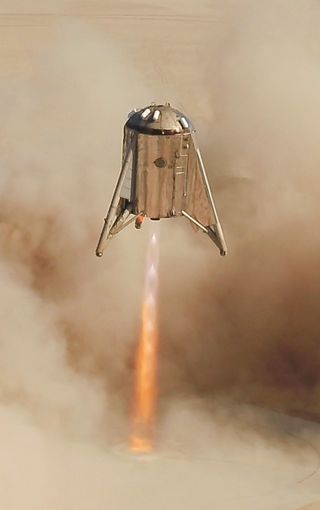
A gorgeous photo shows SpaceX's Starhopper vehicle coming back down to Earth for the final time.
Starhopper, an early test prototype of SpaceX's Mars-colonizing Starship spacecraft, flew high into the South Texas skies yesterday (Aug. 27), acing its fourth and final test jaunt. The one-minute flight took Starhopper several hundred feet up and featured a sideways translation to a landing pad a short distance away.
The new photo, which SpaceX founder and CEO Elon Musk posted on Twitter yesterday afternoon, captures Starhopper just before that touchdown. Dust kicked up by the descent billows around the vehicle, and a column of flame extends from Starhopper's single Raptor engine down the landing pad.
The moment apparently put Musk in a contemplative mood. "One day Starship will land on the rusty sands of Mars," he wrote in the Twitter post.
Related: SpaceX's Starship and Super Heavy Mars Rocket in Pictures
Yesterday's flight brings that future milestone a little closer. Starhopper has proven its mettle and will now be turned into a Raptor test stand, Musk has said. The next test flights will reach Earth orbit, and they'll be performed by advanced prototypes known as Starship Mk1 and Mk2.
Mk1 is being built at SpaceX's facility in Boca Chica, the site that has hosted Starhopper's forays into the sky. Mk2 is coming together on Florida's Space Coast. The idea is to improve the design of the final 100-passenger Starship by spurring some intracompany competition, Musk has said.
Get the Space.com Newsletter
Breaking space news, the latest updates on rocket launches, skywatching events and more!
Both Mk1 and Mk2 will sport at least three Raptors. The operational Starship will have six engines, and the Super Heavy rocket that will launch the spacecraft from Earth will be powered by 35 Raptors, Musk has said. (Those numbers could change, however; the billionaire entrepreneur has promised a Starship design update soon.)
If all goes according to plan, Starship and Super Heavy could start launching satellites as early as 2021 and begin flying people just two years later. Indeed, Japanese billionaire Yusaku Maezawa has booked a Starship flight around the moon that's currently targeted for 2023.
Starhopper's first two hops took place in early April. On both occasions, the vehicle was tethered for safety's sake and barely rose off the ground. Starhopper was unleashed for the first time on July 25, when the stubby prototype soared on a flight with a maximum expected altitude of 65 feet (20 meters). Yesterday's flight had a ceiling of 150 m (about 500 feet), a limit imposed by the U.S. Federal Aviation Administration.
- SpaceX's Starship and Super Heavy Mars Rocket in Pictures
- See the Evolution of SpaceX's Rockets in Pictures
- SpaceX's Raptor Engine Hits Power Level for Starship Launches
Mike Wall's book about the search for alien life, "Out There" (Grand Central Publishing, 2018; illustrated by Karl Tate), is out now. Follow him on Twitter @michaeldwall. Follow us on Twitter @Spacedotcom or Facebook.
Join our Space Forums to keep talking space on the latest missions, night sky and more! And if you have a news tip, correction or comment, let us know at: community@space.com.

Michael Wall is a Senior Space Writer with Space.com and joined the team in 2010. He primarily covers exoplanets, spaceflight and military space, but has been known to dabble in the space art beat. His book about the search for alien life, "Out There," was published on Nov. 13, 2018. Before becoming a science writer, Michael worked as a herpetologist and wildlife biologist. He has a Ph.D. in evolutionary biology from the University of Sydney, Australia, a bachelor's degree from the University of Arizona, and a graduate certificate in science writing from the University of California, Santa Cruz. To find out what his latest project is, you can follow Michael on Twitter.
